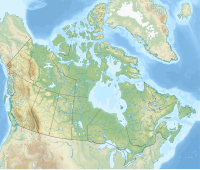Aurora Mountain
Appearance
| Aurora Mountain | |
|---|---|
| Highest point | |
| Elevation | 2,790 m (9,150 ft)[1] |
| Prominence | 250 m (820 ft)[2] |
| Parent peak | Mount Byng (2940 m)[2] |
| Listing | |
| Coordinates | 50°49′30″N 115°32′34″W / 50.82500°N 115.54278°W[3][4] |
| Geography | |
| Country | Canada |
| Provinces | Alberta and British Columbia |
| Protected area | Banff National Park[5] |
| Parent range | Blue Range[5][3] |
| Topo map | NTS 82J13 Mount Assiniboine[3] |
| Climbing | |
| First ascent | 1916 Interprovincial Boundary Commission[2][6] |
Aurora Mountain is located in the Blue Range of the Canadian Rockies, which forms part of the Continental Divide and the provincial boundary between British Columbia and Alberta.[6][2] It is named after HMS Aurora, a British Royal Navy light cruiser launched in 1913 that was transferred to the Royal Canadian Navy in 1920.[7][8] The mountain was originally named Mount Aurora in 1916 by a survey party but was changed in 1957 to its current name.[8]
See also
[edit]References
[edit]- ^ Banff & Mount Assiniboine (Map). Gem Trek Publishing. 1997.
- ^ a b c d "Aurora Mountain". Bivouac.com. Retrieved Feb 21, 2009.
- ^ a b c "Aurora Mountain (AB)". Geographical Names Data Base. Natural Resources Canada. Retrieved 2025-03-30.
- ^ "Aurora Mountain (BC)". Geographical Names Data Base. Natural Resources Canada. Retrieved 2025-03-30.
- ^ a b NTS map sheet 82J13 Mount Assiniboine
- ^ a b "Aurora Mountain". cdnrockiesdatabases.ca. Retrieved Feb 21, 2009.
- ^ Place-names of Alberta. Ottawa: Geographic Board of Canada. 1928. p. 14.
- ^ a b "Aurora Mountain". BC Geographical Names. Retrieved 2025-03-30.



